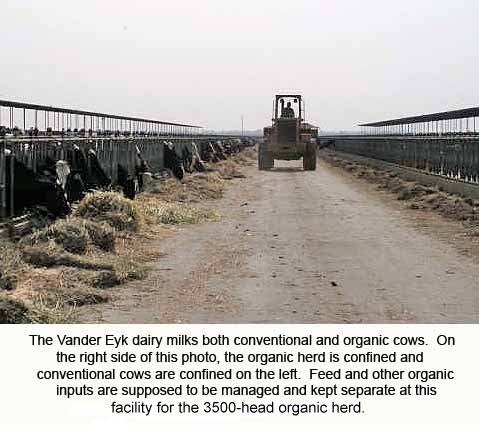The Organic Community Summit
June 18, 2007
Dear Organic Stakeholders,
Approximately a hundred diverse members of the extensive organic community met on Monday, June 18, in an effort to reach consensus on issues of deep concern to members of the organic movement that includes a wide range of commercial entities, consumers, advocates, and farmers. The teleconference was quickly put together in response to the highly exclusive nature of the so-called Organic Summit due to meet this week in Boulder, Colorado.
When many of us first heard of that meeting, we assumed that the term summit was indicative of an all-inclusive gathering of the whole organic industry/community. However, due to a limit on the number of participants, high fees and hotel costs, transportation expenses to Colorado (far from where the majority of organic production takes place), as well as scheduling the event during the busy farming season, it became apparent that this discussion of organics was primarily designed for business leaders and industry representatives, with just a smattering of selected community delegates. We were motivated to sponsor the Organic Community Summit when we learned that many key participants would be excluded from joining what was billed as the “new organic conversation” with "industry leaders" in Boulder.
The Community meeting featured two keynote speakers. Jim Riddle, former
National Organic Standards Board chair, said organics encompasses a
wide range of farmers, activists, academics, business people, and
regulatory personnel, and “in harmony we thrive.” He said the organic
movement has strong roots, and this is a time of great opportunity for
the whole community, as organic agriculture is best positioned to meet
today’s paramount challenges of climate change, energy use, and
sustainable food production. These issues were underscored by the
second keynoter, Fred Kirschenmann, a universally respected organic
leader and also former member of the NOSB, in the context of the
longtime organic movement, which grew out of the commitment to soil
health principles espoused by its early pioneers. He also referred to
the tension the organic community is experiencing with the
commercialization and mainstreaming of movement ideals and the need for
the entire industry to move beyond this conflict if organic is to
survive as meaningful label in the marketplace.
The remainder of the meeting was open to all the Summit participants.
Others sent comments via e-mail. Participants strongly felt that all
sectors in the organic community (farmers, advocates, consumers,
academics, public interest groups, investors, manufactures,
distributors, and retailers) are vitally important to both the economic
success and realizing the societal benefits that organic food
represents.
Maintaining genuine and meaningful organic standards was high on
everyone’s list. The organic industry is successful because of the high
esteem the consumer holds for organic food and the farmers who produce
it, as well as an authentic approach to food processing, distribution,
and retailing. There is great danger that market acceptance will
rapidly diminish if consumers perceive the integrity of organic is
being breached by business interests looking to capitalize on organics’
good name. Organic production does not mean business as usual in this
respect, but rather resides in the province of socially responsible
business.
In the coming years, climate change, energy conservation, water quality
and quantity, and food security will be the major emerging themes in
this country and around the world. How agriculture reacts to the end of
cheap energy and cheap water resources will have a profound effect on
our well-being and, through impacts of global warming, on the planet.
In all of our deliberations we need to make sure that organic food
production, processing, and distribution remain a proactive alternative
for consumers to meet these profound challenges.
Organic food also needs to remain at the forefront of offering
consumers alternatives to technologies and practices they find
environmentally destructive, a danger to their families’ health, or
morally abhorrent. In the near term, animal cloning, genetic pollution,
livestock confinement operations, as well as the exponential growth of
imports and concomitant food safety problems will be high-profile
issues that have the potential to showcase the vastly superior organic
alternative.
To keep organics healthy, other important issues will also need to be
addressed. There is wide concern that smaller farmers and processors
are being squeezed out in terms of distribution opportunities and
escalating costs at the USDA for certification. Also, aggressive action
is needed to recruit and train new, young farmers to take the place of
retiring organic producers and to meet increasing demand for organic
commodities—domestically. The word local needs to be respected and
continued to be associated with organics. Shipping food around the
country, or around the world, does not conform to the expectation of
the organic consumer. And more needs to be done to facilitate market
access by smaller, dedicated farmers, who are held in high esteem by
the consumers. These family-scale farmers are the "face of organics”!
Overall, we need a greater level of transparency, both in the processes
and ingredients used to manufacture organic food and in the oversight
of our industry by the USDA. At the same time, the National Organic
Program needs a much higher level of funding, as does organic research.
Industry clout could be a positive force for change at the political
level to support and expand all aspects of organic agriculture.
In closing, we need to move toward a unified industry. The fact that we
felt compelled to hold a Community Summit in the same week that
industry interests were holding their Summit is counterproductive and a
loss of a great opportunity to join experienced and passionate people
in the common goal of furthering the organic movement. This message,
and our gathering, were not intended to be "anticorporate." We
absolutely welcome corporate investors into the organic market. Their
capital and expertise have broadened both product offerings and
distribution and are an integral part of organics’ success. But, the
commercial sector needs to carefully consider the long-term
implications of not respecting the high standards created by the
organic community/industry. If we lose the integrity of the organic
standards, we will rapidly lose organics’ preeminence in the
marketplace.
We all look forward to future meetings that are truly legitimate
gatherings of the entire organic community. Together, we can ensure
that organic food and farming offer healthy returns to farmers and
investors, respectful employment to all those involved in such an
important enterprise, respect for the Earth, a productive, sustainable,
safe, and nutritionally rich food supply that meets modern energy and
climate challenges, and a positive “green” model for society.
Sincerely yours, on behalf of all those who participated in Monday's Organic Community Summit,
Barth Anderson
The Wedge Co-op
The nation's largest single-store natural foods cooperative
Dave Engel
Certified organic dairy farmer
Natures International Certification Services
Ronnie Cummins
Organic Consumers Association
Steven Heim
Expert in corporate responsibility and ethical investing
Boston Common Asset Management
Steve Gilman
New York Organic Farming Activist
Michael Potter, CEO
Eden Foods
Ken Rabas
Farmers All-Natural Creamery
Mark Kastel
The Cornucopia Institute
Trudy Bialic
PCC Natural Markets
The nation’s largest consumer-owned grocery Cooperative
Goldie Caughlan
PCC Natural Markets
Former member: National Organic Standards Board
Organizations listed are for identification purposes only




 A fascinating
A fascinating